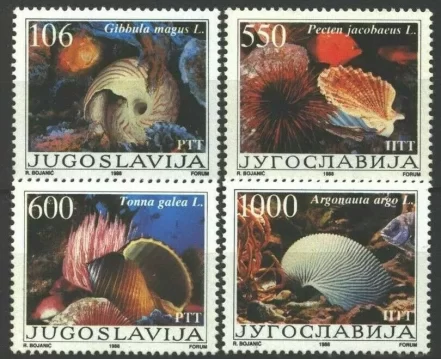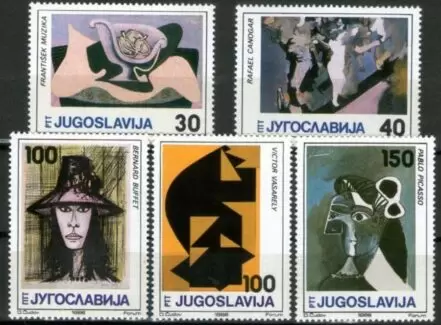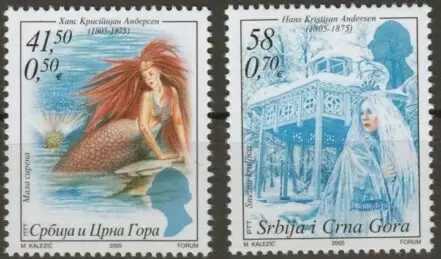Yugoslavia 1988 Marine Life – Molluscs- Complete set MNH**
Molluscs are a diverse group of invertebrate animals belonging to the phylum Mollusca. They are found in marine, freshwater, and terrestrial environments and include a wide variety of species with different body shapes, sizes, and lifestyles. Here’s an overview of marine molluscs:
- Gastropods: Gastropods are the largest class of molluscs and include familiar marine species such as snails, slugs, and nudibranchs. They are characterized by a single, coiled shell (in most species) and a muscular foot used for locomotion. Gastropods inhabit a wide range of marine habitats, from rocky shores and coral reefs to deep-sea environments.
- Bivalves: Bivalves are molluscs with two hinged shells, such as clams, mussels, oysters, and scallops. They are filter feeders, using specialized gills to extract food particles from the water. Bivalves are important components of marine ecosystems, providing food for other organisms and playing a role in nutrient cycling and sediment stability.
- Cephalopods: Cephalopods are highly evolved molluscs with a distinct head, large eyes, and tentacles equipped with suction cups. This class includes species such as squids, octopuses, cuttlefish, and nautiluses. Cephalopods are known for their complex behaviors, intelligence, and sophisticated nervous systems. They are active predators, using their speed, agility, and camouflage to hunt prey and avoid predators.
- Chitons: Chitons are primitive molluscs with a shell composed of eight overlapping plates. They are found in intertidal and subtidal zones, where they graze on algae and detritus using a radula (a specialized feeding organ). Chitons are often found clinging to rocks or other hard substrates in coastal areas.
- Other Groups: Mollusca also includes several smaller classes of marine organisms, such as scaphopods (tusk shells), polyplacophorans (chitons), and aplacophorans (worm-like molluscs). While less well-known than gastropods, bivalves, and cephalopods, these groups contribute to the diversity and ecological functioning of marine ecosystems.
Marine molluscs play important ecological roles as primary consumers, filter feeders, predators, and prey in marine food webs. They are also economically significant, providing valuable resources such as food, pearls, shells, and materials for biomedical research. However, many marine mollusc populations are threatened by habitat destruction, pollution, overfishing, and climate change, highlighting the need for conservation measures to protect these important organisms and their habitats.










Reviews
There are no reviews yet.